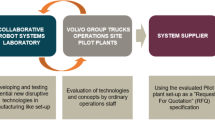Abstract
The objective of collaborative manufacturing is to create the synergism from the collaboration of manufacturing resources. Most of the studied collaborations are made among intelligent machines; however, the collaboration can be realized even between machines and human being, and a collaborative robot (Cobot) belongs to the latter. A cobot is a robot designed to assist human beings as a guide or assistor in a constrained motion. Various prototypes have been developed and the potentials of these robots have been demonstrated. The research presented in this paper focuses on the control and simulation models of a tricycle cobot with three steered wheels, with the following two contributions: (i) A concise model for the closed-loop control is developed. Existing closed-loop control has been implemented in an intuitive way, and some control parameters have to be determined by a trial-and-error method. (ii) A simulation model is proposed to validate the control algorithms. No simulation model is available and the control models of other existing systems have to be validated experimentally. The developed control and simulation models have been implemented. Graphic simulation is also developed. Case studies are provided and the simulation results are analyzed.
Similar content being viewed by others
References
Belyaev, A. (2006). Plane and space curves, curvature, curvature-based features, http://www.mpi-sb.mpg.de/~belyaev/gm06.
Boy, E. S., Burdet, E., Teo, C. L., & Colgate, J. E. (2003). Motion guidance experiments with scooter cobot. In Proceedings of the 11th Symposium on Haptic Interfaces for Virtual Environment and Teleoperators Systems, HAPTICS 2003 (pp. 63–69).
Gillespie R.B., Colgate J.E. and Peshkin M.A. (2001). A general framework for cobot control. IEEE Transactions on Robotics and Automation 17(4): 391–401
Hodgson A.J. and Emrich R. (2002). Control of a minimally constrained cobot. Journal of Robotic Systems, special section on robot and human integration 19(7): 299–314
Jabre, L., McGrew, R., Gillespie, R. B., & Goleski, P. (2002). An assistive cobot for aid in self care activities. 2nd IFAC Conference on Mechatronic Systems, Berkeley, CA, December, 2002.
MESA. (2004). Collaborative manufacturing explained. http://www.automationworld.com/images/sponsored_content/wp_mesa_cme.pdf.
Mills, A. L. (1998). An analysis of position and velocity sensor systems for a 3 degree-of-freedom planar collaborative robot. MS thesis, Northwestern University, USA.
Nejatbakhsh, N., Hirata, Y., & Kosuge, K. (2005). Passive omnidirectional walker—design and control. In 12th International Conference on Advanced Robotics, ICAR ’05, July 18–20, 2005, pp. 518–523.
Paula, G. (1997). Cobots for the assembly line. http://www.memagazine.org/backissues/october97/features/cobots/cobots.html.
Peshkin M. and Colgate J.E. (1996). ‘Cobots’ work with people. IEEE Robotics & Automation Magazine 3(4): 8–9
Peshkin, M., Colgate, J. E., Akella, P., & Wannasuphoprasit, W. (2000). Cobots in materials handling. http://www.mech.northwestern.edu/colgate/Website_Articles/Book_Chapters/Peshkin_2000_CobotsInMaterialsHandling.pdf.
Peshkin M.A., Colgate J.E., Wannasuphoprasit W., Moore C.A., Gillespie R.B. and Akella P. (2001). Cobot architecture. IEEE Transactions on Robotics and Automation 17(4): 377–390
Stanley. (2002). Intelligent assist devices: Revolutionary technology for material handling. http://www.stanleyassembly.com/documents/en/Cobotics%20IAD%20White%20Paper.pdf.
Townsend, B., Radford, M., & Groves, A. (2004). Collaborative robotics with medical applications. Project report 0401, ENPH 459, University of British Columbia, Canada.
Ulrich I. and Borestein J. (2001). The guidecane—applying mobile robot technologies to assist the visually impaired. IEEE Transactions on Systems, Man, Cybernetics—Part A: Systems and Humans 31(2): 131–136
Wannasuphoprasit, W. (1999). Cobots: Collaborative robots. Ph.D. Thesis, Northwestern University, USA.
Wannasuphoprasit, W., Gillespie, W., Colgate, J., & Peshikin, M. (1997). Cobot control. In Proceedings of the 1997 IEEE International Conference on Robotics and Automation (pp. 3571–3576).
Author information
Authors and Affiliations
Corresponding author
Rights and permissions
About this article
Cite this article
Bi, Z.M., Lang, S.Y.T. & Wang, L. Improved control and simulation models of a tricycle collaborative robot. J Intell Manuf 19, 715–722 (2008). https://doi.org/10.1007/s10845-008-0122-4
Accepted:
Published:
Issue Date:
DOI: https://doi.org/10.1007/s10845-008-0122-4




